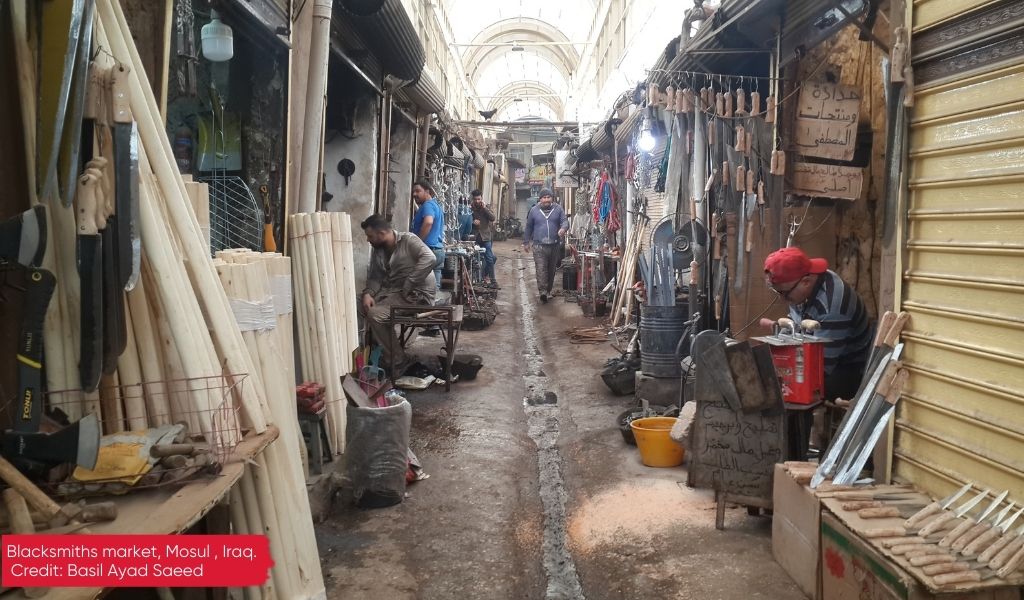Rebuilding heritage and the cohesion of communities that live and breathe it is not merely a matter of rebuilding tangible (often historical) sites, but also is about telling and sharing stories. In this latest blog, which is part of the IDS-led CREID programme initiative to collect and document oral heritage in Iraq and Syria, Basil Ayad Saeed, from the University of Mosul, takes us on a walk through the old city of Mosul, sharing his memories of life there.

Remains of the Chaldean Archbishopric Church in Mosul, Iraq, destroyed by Daesh. Credit: B.A.Saeed
Mosul was one of the most prominent cities in Iraq, due to both its size and illustrious history as a centre of learning. Its diverse heritage and buildings have long reflected the diverse make-up and histories contained within the city.
Prior to its capture by Daesh, the city had been home to Christian, Jewish, Shabak, Shi’a, Sunni and Yezidi communities among others. However, following the devastation wrought upon Mosul by Daesh many of these groups have been displaced from the city that was once their home.
In a recent roundtable discussion hosted by CREID, Basil Ayad Saaed, a lecturer in the archaeology department at the University of Mosul, described how the city had once been like a rose garden, filled with different varieties of roses which contributed to the beauty of the place. Consequently, I invited him to write a blog which take us on a walk through the old city of Mosul and in which his memories of life before Daesh serve as a means of directly preserving the heritage of Mosul and recognising the rights of the different groups who had lived there. In this way it is not only through the rebuilding of tangible sites that heritage can be safeguarded, but also through the stories we share about them. [Introduction written by Sofya Shahab, leading the CREID Heritage Work in Iraq and Syria.]
Memories of Mosul – by Basil Ayad Saeed
I have memories of a part of my life that I greatly miss: the heritage souks of Mosul.

Blacksmiths market, Mosul, Iraq. Credit. B.A. Saeed
These markets reside within the Old Town of Mosul which sits on the right bank of the Tigris River and divides the city in two. My home lies half an hour away from the old city by foot and every Saturday my friends and I would walk to the fish market for a delicious meal of fresh fish that we would eat together in the square. This was the first entry point into the Farouq area of the Old Town famous for its distinctive arches which would cross the narrow streets and connect the old houses made from stones from the quarries to the south of the city. The Christians of the city were especially renowned for their construction of the arches, the alley they passed above were only about a meter wide and contained dye and calligraphy shops, as well as those of craftsmen who would make household items and decorations.
Together with my friends, we would then cross the alleys of Al-Farouq towards the ruins of the ancient Castle of Bashtabiya, its foundations dating back to the second century of Hijra (the eighth century CE). There we would talk about our dreams and our failures as we watched the flowing waters of the Tigris. After our reflections we would head towards the mausoleum of Yahya Abu al-Qasim, where we would read Al-Fatiha – the first chapter of the Qur’an – and continue on our way to the Virgin Mary Church, which sits opposite Al Imam Muhsin Mosque. We used to be able to see how these diverse aspects of Mosul’s heritage and the religions of its people sat next to each other, but now these histories and peoples have been left in ruins by Daesh.
On the way to the church, we pass local fishermen with their small wooden boats that are particular to Mosul. This is an unusually quiet part of the city as the fishermen sit in silence so as not to scare the fish away. We would take a break under the fifth bridge (one of the bridges connecting Ayman Mosul to Hissra) where there is a football field and we would spend some time cheering on the popular teams.
The next square is the center of the fish market and where the wooden boats and fishing nets are manufactured. This used to be a part of the city where you could see many people of different religions working together, to make the nets, captain the boats and catch the fish. However, now many of these people have left and it has become more common to import these items rather than to make them locally.
The market of Safarin, was one of the most beautiful markets of the city in which craftsmen would sell their copper carvings. The city of Mosul has been known for its metal manufacturing since ancient times as it was exported throughout the Arab world. The Mosuli school of carving has a distinctive style that is characterised by the use of human and animal figures engaged in different hunting scenes and had a significant impact on other schools.
Under the rule of Daesh and following the battle by Iraqi and coalition forces to retake the city, almost two thirds of the markets I would travel through with my friends have been completely or partially destroyed. This has not only impacted the physical elements of the city, but has led to certain industries disappearing from those markets, changing the sense of place. While much has been lost, our memories of how the city used to be still remain.



